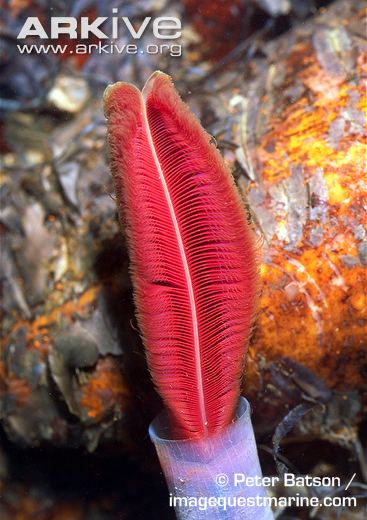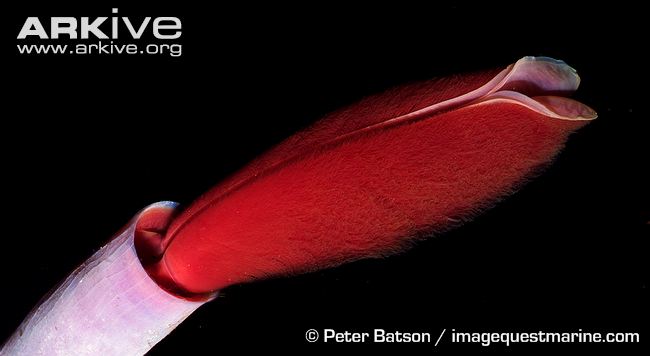Form and Function
By: Roslyn Walhovd
At first glance
Riftia
pachyptila seems to be a very simple organism, some would even compare it to
a paintbrush with its basic visible structures consisting of a long
chitonous tube, and red plume (Zal, et. all 1996). However it can stand at over 2.4 m tall
(Governar, et. all 2004). To survive and thrive in such a harsh environment it has adapted in
several ways in form and function giving it the subtle but extraordinary
morphological characteristics we will be exploring in detail. This worm is
one of the most predominant fauna for hydrothermal vents and its mere
survival has intrigued scientists for years (Black, et. all 1997)
 First and foremost it is very important to realize that Riftia pachyptila
lacks a mouth,stomach, digestive tract, or any means of photosynthesis
(which would prove useless over 2 Km below the surface anyway) (Hand, 1987). So how
is this organism even alive? The answer is its symbiotic relationship with a
sulfur-oxidizing chemoautotrophic endosymbiotic bacterium. These are special
bacteria that can provide nutrients by using the usually toxic chemicals
being spewed out by the hydrothermal vents via chemoautotrophism.
First and foremost it is very important to realize that Riftia pachyptila
lacks a mouth,stomach, digestive tract, or any means of photosynthesis
(which would prove useless over 2 Km below the surface anyway) (Hand, 1987). So how
is this organism even alive? The answer is its symbiotic relationship with a
sulfur-oxidizing chemoautotrophic endosymbiotic bacterium. These are special
bacteria that can provide nutrients by using the usually toxic chemicals
being spewed out by the hydrothermal vents via chemoautotrophism.
They live in colonies inside the worm’s trophosome
that is pictures to the left. (Feldbeck, 1981)(Hand,1987). The worm
provides shelter and draws in the materials needed for the bacteria through
its specialized plume. This bright red plume draws in hydrogen sulfide,
carbon dioxide, and oxygen from the seawater, which is moved into the
trophosome. The bacteria can then use these ingredients to perform
chemosynthesis turning oxygen, hydrogen sulfide, carbon dioxide, etc. into
organic molecules (Hand, 1987)(Marakushev et. all 2011).
The red plume of
Riftia pachyptila is an adaptation worth exploring in more detail.
This plume is a very important part of the worms vascular system. It
consists of large amounts of hemoglobin giving it the ability to exchange
materials between the worm and the surrounding seawater like mentioned
before (Hand, 1987)(Governar, et. all 2004). This allows the worm to collect the necessary components to
keep “feeding” its bacterial symbiont (Minic and Herve, 2004). This plume acts almost as a gill
system for the worm and is vital because the rest of Riftia pachyptia is not
in direct contact with the environment (Feldbeck, 1981)(Zal, et. all 1996). It also however is a bright
red flag for predators like some crabs and shrimp that try to feed off of
the plume. Riftia Pachyptila again has another specialized characteristic;
being able to retract this plume during times of stress and in the process
of reproduction. This is beneficial to avoid predation by fish and crabs (Governar, et. all 2004)(Feldbeck, 1981).

Worth mentioning is the growth of Riftia
pachyptila. As touched on briefly before we know that they can grow to over
2.4 m in height. What is even more amazing about this, is the small amount
of time needed for this type of growth. Today it still has the fastest
growth rate of any known marine invertebrate (Governar, et. all 2004). After the worms larval
stage it has been observed to reach heights as tall as 1.5 m in only 2 years
(Governar, et. all 2004). Although these seem like extreme heights for an organism in such harsh
conditions it is important to keep in mind the actual worm may only inhabit
a portion of the total length of its tube (Governar, et. all 2004). But it
is nonetheless an astonishing creature.
In conclusion with some deeper investigation we see the deeper complexity within the plain looking Riftia pachyptila. Holder of the fastest growth rate for marine invertebrates, faithful companion of chemoautotrophic bacterial symbionts, and proud owners of hemoglobin filled plumes, it proves itself anything but plain.
Continue on to Fun Facts!